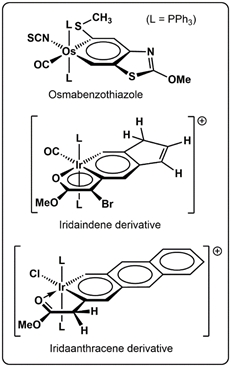Abstract
Recently, there is a growing interest in the study of metalla-analogues of organic aromatic compounds, in which a transition metal and its ancillary ligands formally replace one of the carbon atoms. Although a considerable number of metallabenzenes have now been isolated and studied, the fused-ring analogues remain much less explored. Studies carried out so far on these fused-ring compounds have demonstrated that, as with metallabenzenes, the chemical reactivity and properties are significantly modified by the transition metal.
The speaker has synthesized recently a number of different fused-ring metallabenzenes, including the examples depicted in Figure 1. In this lecture, the different synthetic routes to these and other related compounds, as well as the spectroscopic and structural properties they display, will be presented. In addition, the chemical reactivity of the fused-ring compounds will be discussed. Comparisons to both the simple organic analogues and to the corresponding metallabenzenes will also be made.

Figure 1. Selected fused-ring metallabenzenes |
About the speaker
Prof Leonard James Wright received his PhD in Chemistry from the University of Auckland in 1980. He joined the Stanford University in 1981 as a postdoctoral research fellow and returned to the University of Auckland in 1984, where he is currently the Professor of Chemical Sciences.
Prof Wright’s research covers a wide range of topics, but general underlying themes are transition metal chemistry and green chemistry. He synthesizes and studies new compounds that display a broad diversity of reactivities, structures and bonding types. In some cases, such as the studies of metallabenzenes and inorganometallic chemistry, he investigates the fundamental properties of materials with unprecedented structures, bonding types or reactivities.
Prof Wright was the co-recipient of the US Presidential Green Chemistry Challenge Award (1999) and he was also elected as a fellow of the New Zealand Institute of Chemistry.
|


